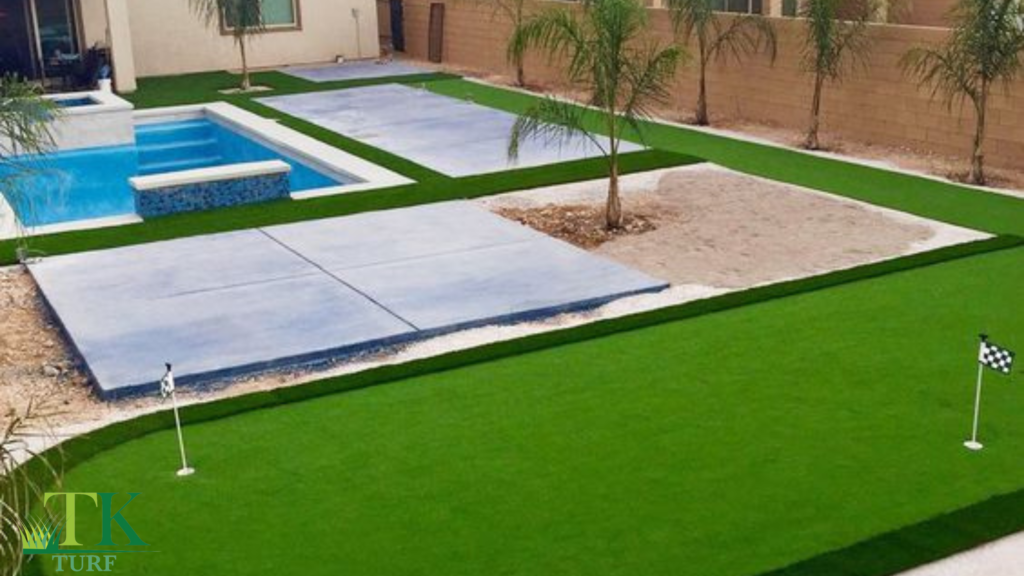Choosing synthetic grass for your yard is a significant decision that can offer numerous benefits. However, to make the best choice, it’s essential to consider various factors. Here are the key things to keep in mind:
1. Quality of the Turf
- Materials: Look for high-quality materials like polyethylene or nylon, which are durable and offer a more natural appearance.
- Pile Height: Consider the pile height (length of the grass blades). Shorter piles are more durable, while longer piles offer a more natural look.
- Density: Denser turf feels more realistic and is more durable. Higher stitch rates and heavier face weights indicate higher density.
2. UV Protection
- UV Stabilization: Ensure the turf has UV stabilizers to prevent fading and degradation from prolonged sun exposure, especially important in sunny climates.
3. Infill Material
- Types of Infill: Common infill materials include sand, rubber, and silica. Each type has its pros and cons regarding cushioning, drainage, and temperature control.
- Purpose of Infill: Infill helps keep the grass blades upright, provides cushioning, and aids in drainage.
4. Drainage System
- Proper Drainage: Ensure the turf has an effective drainage system to prevent water pooling and promote quick drying after rain or cleaning.
- Backing Material: Look for turf with a permeable backing that allows water to pass through easily.
5. Installation
- Professional Installation: Consider hiring professionals for installation to ensure proper base preparation, seam joining, and infill application.
- DIY Considerations: If you opt for a DIY installation, ensure you follow all guidelines for base preparation, turf placement, and securing seams.
6. Maintenance Requirements
- Regular Cleaning: While artificial turf is low maintenance, it still requires regular cleaning to remove debris and prevent odors.
- Brushing: Periodic brushing helps maintain the upright position of the grass fibers.
- Infill Maintenance: Occasionally adding or redistributing infill may be necessary to maintain cushioning and appearance.
7. Environmental Impact
- Eco-Friendly Options: Some synthetic grass are made from recycled materials or are recyclable. Consider the environmental impact of your choice.
- Water Conservation: Artificial grass conserves water compared to natural grass, an important factor in regions with water restrictions.
8. Cost
- Initial Investment: Synthetic grass involves a higher initial cost compared to natural grass. Consider your budget and the long-term savings on maintenance and water bills.
- Long-Term Savings: Factor in the reduced costs of lawn care equipment, fertilizers, pesticides, and water over the lifespan of the turf.
9. Purpose and Usage
- Primary Use: Consider how you will use the turf. High-traffic areas, sports fields, and pet areas may require different types of synthetic grass.
- Safety Features: For play areas, look for turf with added cushioning to reduce the risk of injury from falls.
10. Aesthetic Preferences
- Color and Texture: Synthetic turf comes in shades of green and textures. Choose one that closely resembles natural grass and complements your landscape.
- Natural Look: Some turfs have a mix of blade colors and thatch layers to mimic the appearance of natural grass.
11. Warranty
- Product Warranty: Look for turf with a good warranty that covers UV degradation, defects, and excessive wear.
- Installation Warranty: Ensure the installation service offers a warranty on their work to cover issues like seam separation or improper installation.
Conclusion
Choosing synthetic grass involves careful consideration of quality, installation, maintenance, cost, and environmental impact. By evaluating these factors, you can make an informed decision that ensures your artificial lawn meets your needs and provides long-lasting beauty and functionality.
TK Turf
2913 W Cypress St Suite 2, Tampa, FL 33609
(813) 534-4220
https://turfgrasstampabay.com/


Recent Comments